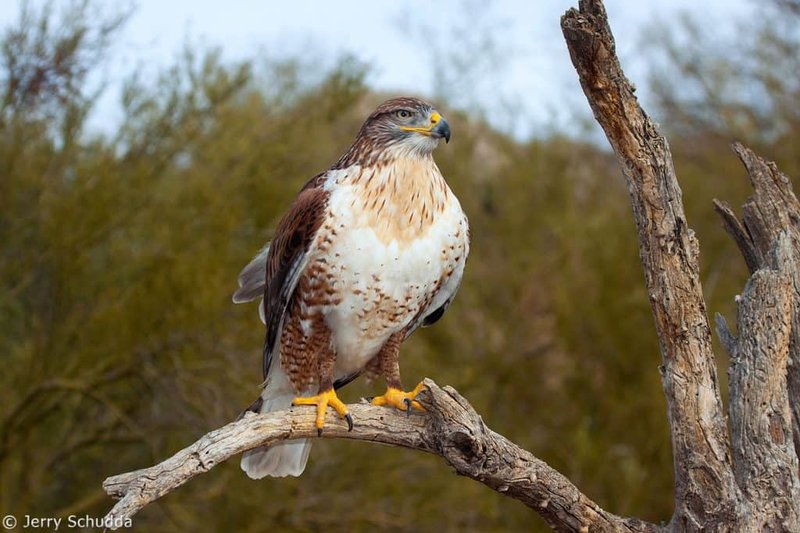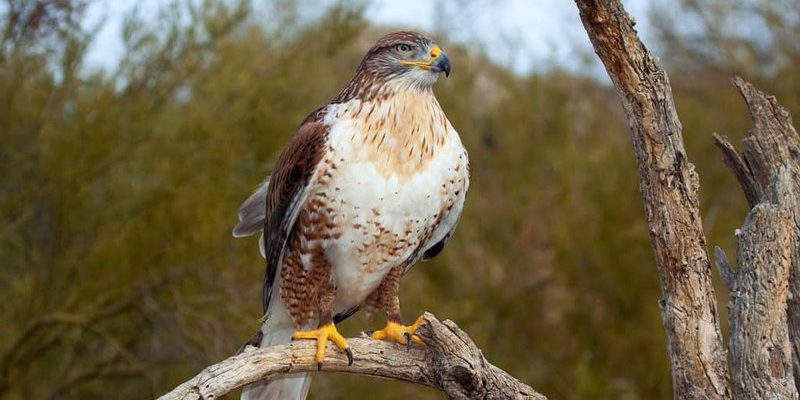
Unlike your typical backyard bird, the Ferruginous Hawk is a bit of a solitary figure, often found in open grasslands and sagebrush steppe. With a wingspan that can reach an impressive 4.5 feet, these hawks are the largest in North America. Now, if you’re ready to learn more about this remarkable bird, let’s take a closer look at ten facts that highlight its beauty, habits, and role in the ecosystem.
1. Unique Coloration
When you first spot a Ferruginous Hawk, you might notice its striking plumage. The ferruginous part of its name comes from the rusty red color that sometimes adorns its feathers. This large raptor features a mix of color patterns, with a light belly, dark brown wings, and a reddish-brown tail. The contrast in colors not only makes them visually appealing but also helps them blend into their environment.
Here’s the thing: these colorations aren’t just for show. The combination of brown and rust helps the hawk camouflage itself while hunting. Picture it scanning the plains for small mammals like rabbits or ground squirrels. The hawk’s feathers help it remain unseen until the right moment to strike.
2. Habitat Preferences
Ferruginous Hawks prefer open spaces over dense forests. You’ll often find them soaring above vast grasslands, fields, and even deserts. They favor habitats where they can easily spot their prey from high above. In these environments, they rely on a combination of keen eyesight and patience to hunt.
Interestingly, they build their nests in high places, like cliffs or tall trees. They often reuse and repair old nests, which can be quite large. Imagine a cozy birdhouse, but much bigger and sturdier. These nests can be several feet across, providing a safe environment for their young chicks.
3. Diet and Hunting Techniques
You might be wondering what these hawks eat. Generally, Ferruginous Hawks have a diet primarily composed of rodents, but they’re not picky eaters. They also hunt birds, reptiles, and even insects when the opportunity arises.
Their hunting strategy is fascinating. Using their incredible eyesight, they scan the ground for movement. They can spot prey from a distance, then swoop down at high speeds to capture it. Once they’ve made a catch, they hold it tightly with their strong talons. It’s like having a built-in grasping tool for their meals!
4. Nesting Habits and Reproduction
When it comes to raising the next generation, Ferruginous Hawks are dedicated parents. They typically mate for life, returning to the same nesting site year after year. The female lays about two to four eggs, which are usually incubated for around 30 to 35 days.
Once the eggs hatch, both parents take turns caring for the chicks, ensuring they’re well-fed and protected. After about six weeks, the young hawks are ready to leave the nest, but they continue to rely on their parents for support until they can hunt on their own. It’s a great example of teamwork in the animal kingdom!
5. Migratory Patterns
Ferruginous Hawks are primarily migratory birds. Depending on their location, they may travel significant distances to find food and favorable nesting conditions. For example, hawks in the northern parts of North America usually migrate south for the winter, while those in milder climates may stay put.
This migration can involve impressive journeys. Imagine a long road trip where every stop is a new opportunity to find food and shelter. As they travel, Ferruginous Hawks can cover hundreds of miles, showcasing their incredible stamina.
6. Conservation Status
Like many wildlife species, Ferruginous Hawks face challenges due to habitat loss and environmental changes. These birds are considered to be of least concern, but their populations can fluctuate due to factors like agricultural expansion and pesticide use.
Conservation efforts are in place to monitor their populations and habitats. By protecting the grasslands and environments where these hawks thrive, we can help ensure they continue to soar through our skies for years to come.
7. Other Names and Cultural Significance
The Ferruginous Hawk goes by a few other names, including the Ferruginous Rough-legged Hawk. In some cultures, these birds symbolize strength and freedom. Their impressive hunting skills and soaring flights make them a source of inspiration in art and literature.
In Native American culture, hawks are often viewed as messengers. The Ferruginous Hawk, with its vivid presence, can represent clarity, focus, and vision—qualities we all strive for in our everyday lives.
8. Vocalizations
If you ever hear a Ferruginous Hawk, you’ll recognize its distinct call. Their vocalizations can include a series of sharp, piercing notes that sound quite different from that of other hawks. Imagine a dog barking in the distance—each note is clear, commanding attention.
These calls are used for communication, especially between mates or when defending their territory. It’s almost like having a conversation in the air, letting other hawks know just who is in charge of that particular hunting ground.
9. Lifespan and Longevity
Ferruginous Hawks have a relatively long lifespan for birds of prey. In the wild, they can live anywhere from 10 to 20 years, depending on factors like food availability and environmental threats. In some cases, those in protected environments have even lived longer!
Their ability to adapt and thrive in various conditions contributes to their longevity. Just like we all seek comfort and safety in our lives, these hawks aim to create stable environments for themselves and their families.
10. Fascinating Fun Facts
To wrap things up, here are a few quick facts about Ferruginous Hawks that might surprise you:
- They have a wingspan that can reach up to 4.5 feet, making them one of the largest hawks in North America.
- Their vision is exceptional—these hawks can see prey from great distances, sometimes a mile away!
- Ferruginous Hawks have been known to hunt cooperatively, working together to catch larger prey.
- Their feathers are thick and warm, allowing them to survive in colder climates during migration.
As you learn more about the Ferruginous Hawk, you realize that it’s not just a bird but a vital part of our ecosystem. Understanding its habits helps us appreciate the delicate balance of nature. So, the next time you see one gliding through the sky, you can admire not only its beauty but also its remarkable story.
In the end, these hawks remind us of the wonders of wildlife and the importance of protecting their natural habitats. Keep an eye out for these magnificent birds and enjoy the show they put on for us!

